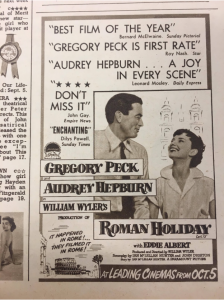
The artefact that we have chosen to critically interrogate is an advert from the fan magazine Picturegoer. Upon investigation, we were able to discern a range of strategies including the decision to shoot on location and the tactical choice of stars to perform in order to take on the principle roles in the film.
A particular point of interest in this advert is the blatant repetition of the star names: Gregory Peck and Audrey He
pburn. Initially, billing rights were possessed solely by Peck, but upon realising Hepburn’s innate and captivating talent, stating that “she was going to win an Oscar in her very first performance” (Snider, Eric D.), he agreed to co-billing; allowing Hepburn’s name to be presented in print on adverts. This repetition of both actors’ names in bold and outlandish font, captivates audiences and coerces them to engage with not only the star-image, in which opinions are formed and cultivated, but also encourages audiences to engage with the film itself as a profitable product. Additionally, repetition coerces the reinforcement of Audrey Hepburn and Peck being depicted as international film stars. The image takes up both the middle and right-third of the advert; dominating the space as it depicts the two stars in an endearing stance, interlocking glances whilst conforming to the genre conventions of romance.
Co-productions across domestic Hollywood and European studios were formed and during this time, most of the studios that engaged into co-production had both minority and majority directors; the latter of which would receive greater profit if they were directing the feature film. Grounded in the aim of accumulating profit, we can critically evaluate how Paramount used Hepburn as a marketing commodity used in the advertising of Roman Holiday. Hepburn’s image transforms into a marketing tool through the repetition of her star-image. Additionally, Paramount took advantage of her family history, (having descended from Dutch aristocracy,) and used it as a unique selling point to encourage sales of the film within the european audiences.
Within this article it is made very clear that the film was shot on location, as it is printed bottom left of the advertisement,‘ it happened in Rome!…They filmed it in Rome!’ The industrial decision to not film in an American studio, would have been an effective European co-production strategy, portraying Rome as a desirable tourist destination. This chosen strategy not only would have positively affected Rome, in the way the world would perceive the country after watching the film, but also economically beneficial for Paramount studios. As the workers on the film, who were hired from Italy, were just as skilled but much cheaper to hire. The location of Rome would also have attracted a wider target audience, as incorporating the sights of Rome would have given perhaps relatability for the European audience. Italy being the focus for Hollywood’s spotlight throughout ‘Roman Holiday’, rather than the predominantly used location of America. This idea is also suggested through the use of Roman architecture iconography, represented by the illustrations of the Roman Colosseum and a more vague drawing of perhaps a church building.
The critical reviews which decorate this poster are chosen to further emphasise the use of particular stars. Whilst critically acclaiming the film itself, the majority of the reviews are focused on the actors Peck and Hepburn themselves. With the statements crying out how “Peck is first rate” and “Hepburn… a joy in every scene” it truly draws the attention to those stars and the excellence of their performance in the film. While the reviews are very complimentary towards the film, describing it as “enchanting”, the concern does not appear to heavily rely on the story, but rather stardom and spectacle which really became prominent in this era of film history. The reviews that do center on the actual film ignite high expectations, naming it the “best film of the year” and therefore encouraging everyone to watch it, regardless of their specific taste in genre. It positions Audrey as an inspirational icon before she is even properly known to the audience and subsequently formulates a large following of fans and admirers who idolise her still this very day.
GOOD PRACTICE FEEDBACK
This is a very good analysis of the ad offering some productive contextualisation, considering how the emphasis upon star names relates to the production history of the text, and connecting this to the particular strategies of the ad in its use of elements such as font, repetition and illustrations. What’s especially good here is the attention to specific details in how the add is composed and arranged, reading it as a ‘text’ in its own right. The observation about how stardom eclipses story is a particularly productive point for understanding how the film was packaged to audiences.